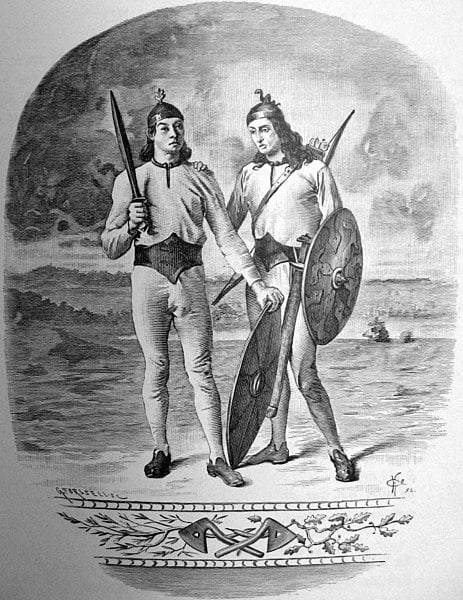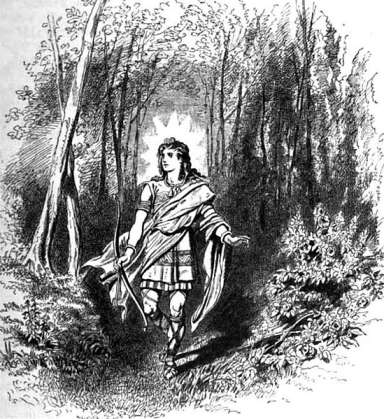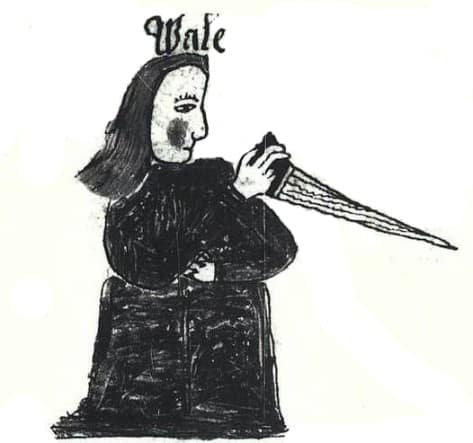Among the gods and goddesses of Norse mythology, Vali stands out because of the circumstances of his conception, and purpose in life. In the aftermath of the death of Baldur, Odin learns from a völva that he will have a son that will avenge Baldurs’ death.
It is not clear to me exactly why Odin’s choice as a mother falls on Rindr. However, that detail was probably known to the Vikings, but have been lost to us. The result of their union is the son Vali, who only a day old grows into adulthood and slays Hodr, and later kills Loki’s son Narfi. As tales of bloody revenge goes, Vali’s is an especially interesting one I think.
Vali Key Facts
| Keyword | Fact |
|---|---|
| Parents | Odin and Rindr |
| Partners | None known |
| Siblings | Thor, Balder, Hodr, and others |
| Offspring | None known |
| Tribe | Aesir |
| Old Norse name | Váli |
| Other names | None known |
| The God of | Vengeance |
Name and Etymology
In Old Norse, “Váli,” is rooted in the Old Norse verb “vala,” meaning the act of choosing or selecting. To me it is a bit difficult to understand who it is that is making a choice in his story. His path is laid down even before his birth, so he has no choice in the matter. It could be that he is Odin’s chosen one, as the avenger of Baldur’s death, but I’m not really sure.
In Snorri’s text “Skaldskaparmal,” Vali’s kennings provide a deeper understanding of his identity and role within the Norse gods. He is referred to as the “Son of Odin and Rindr,” highlighting his divine lineage. As the “Stepson of Frigg,” he is also connected to the core Aesir family.
Both his titles “Baldr’s Avenger” and “Foe and Slayer of Hödr” emphasize his primary purpose and the act that defines his existence. Another kenning “Dweller in the Homesteads of the Fathers” Vali actually shares with Vidarr. To me it evokes a sense of his eternal place among the gods and the ancestral realms.
Ancient roots
Norse mythology is in no way alone in having one or more gods of retribution and vengeance. However, Vali does stand out because of the circumstances of his conception and very narrow purpose.
In Greek mythology they had Nemesis, goddess of vengeance and retribution, going after both mortals and gods. In Hindu mythology they had the warrior goddess Kali, who was also seen as an avenging goddess. Interestingly, they are both godddesses, whereas Vali is a god.
Vali Origins and Family
From several mentions in both the Skaldskaparmal and ancient poems, we know that Odin is Vali’s father, and a woman named Rindr is his mother. However, Rindr is a bit of a mystery. Snorri lists her among the asynjur (Aesir goddesses), in Skaldskaparmal and in the Nafnathulur, but she is not mentioned as a goddess anywhere else. Nor does Rindr appear in any other myths.
While we know Vali’s parents well, a big question is why Odin chose Rindr to be his mother in the first place. I am not able to provide any sources mentioning why the choice fell on her. However, in the Gesta Danorum, by the 12th-century author Saxo Grammaticus, the circumstances of conception is described.
According to that source, Odin in fact raped Rindr. This happened under the guise of needing time alone with her to heal her from an illness Odin had given her in secret. All as a subterfuge to having her bring his son Vali to the world.
In an ancient skaldic poem, Odin is said to have used seidr, the ancient Norse magic, to subdue or charm her. Either way, magic or by force, it seems quite clear that Rindr was an unwilling mother.
Suffice to say, this union was not one of love or desire but of necessity. Odin sought to father a son who would avenge the death of Balder, his beloved son. After he had been tragically killed by his own brother, Hodr, sadly tricked by the god, Loki. Vali’s birth and rapid maturation into adulthood were driven by this singular mission, setting him apart from many other gods in the pantheon.
Siblings

Vali, the avenger of the Aesir, shares his lineage with several prominent figures in Norse mythology. Among his notable siblings is Thor, the god of thunder, born from Odin’s union with the jötun Fjörgyn. Balder, the god of light and purity, and Hodr, the blind god responsible for Balder’s death, are both offspring of Odin and Frigg. Another sibling, Vidar, known as the “Silent God,” is the result of Odin’s union with the giantess Grídr. Bragi, is another half-brother, son of Odin and either the giantess Gunnlod or Frigg. Finally, he is also half-brother to Heimdall, Meili, Hermod and Tyr.
These diverse relationships underscore the complex and often overlapping ties between the Aesir gods and the jötnar, highlighting the multifaceted origins and roles of the gods in Norse tales.
While Vali had no known partners or offspring, his relationships with his siblings, particularly Balder and Hodr, are central to his narrative. His very existence, born out of the need for vengeance, paints a very clear picture of how everyone had their destiny pre-determines within the Norse mythological framework.
Vali Roles And Responsibilities
Born in the aftermath of a tragic event, Vali’s existence is intrinsically linked to the fate of his half-brothers, Balder and Hodr. Balder, known for his radiant beauty and purity, was beloved by all. His untimely death, orchestrated by the malevolent trickster Loki, was a devastating blow to the Aesir gods. The instrument of Balder’s demise was none other than his own blind brother, Hodr, who was manipulated into committing fratricide.

Vali’s birth was a direct response to this tragedy. He was conceived and brought into existence with a singular mission: to avenge Balder’s death. It’s worth noting that Balder’s death occurred before Vali’s birth, emphasizing the urgency and divine intent behind his creation. In his quest for retribution, Vali both exacted revenge on Hodr and took the life of Loki’s son, Narfi. Furthermore emphasizing the depth of his vengeance.
These acts, while serving justice, highlight the intricate web of relationships and the delicate balance of honor and retribution within the Norse pantheon. Through Vali’s actions, the gods sent a clear message about the consequences of treachery and the lengths they would go to uphold their honor and rectify wrongs.
This act of vengeance, while serving justice, also underscores the complexities of fate, relationships, and honor within the Norse pantheon. Vali’s actions served as a stark reminder of the consequences of treachery and the lengths the gods would go to uphold their honor and rectify wrongs.
Play Fun Norse Quiz
Is this article making you even more curious about Norse gods and goddesses? You can satisfy your curiosity by playing a fun Norse mythology quiz. This way, you can test your knowledge about Norse gods and goddesses, as well as fill in some gaps. Good luck and have fun playing!
You might be interested in this fun game too! It reveals the parentage of Vali and other sons (and daughters) of Odin:
Don’t forget to try our other games as well!
Depiction And Characteristics
Vali’s actions speak volumes about his character. Determined, relentless, and driven by a sense of duty, he embodies the concept of divine retribution.
While not as multifaceted as Odin or as beloved as Balder, Vali’s unwavering commitment to his purpose paints him as a figure of respect and, to some extent, pity. After all, his entire existence was defined by a singular act of vengeance. In the Skaldskaparmal he is described as “daring in combat, and a good shot.”
Vali Symbols, Artifacts or Animals
Unlike Thor with his hammer Mjölnir or Odin with his ravens, Vali isn’t typically associated with specific artifacts or animals. However, his very being is symbolic of retribution and justice. In a broader sense, he represents the lengths the gods would go to uphold their honor and the intricate balance of power and relationships within the Norse pantheon.
I do feel though that it might be within reason to think that he was associated with the wolf. He is in fact turned into a wolf to act out part of his retribution. In so doing he might have also been the first of the Ulfhednar (I’ll explain a bit more below).
Myths about Vali
Vali’s narrative in Norse mythology is deeply rooted in the larger tapestry of events and relationships that shape the Aesir gods’ stories. His tale intertwines with the stories of both Balder and Hodr as well as Loki,. Highlighting the often complex web of relationships and events that define the Norse pantheon.
Vali Avenging the Death of Balder
The tragic death of Balder, the beloved god of light and purity, sent shockwaves through the Aesir tribe. Loki’s malevolent machinations led to Balder’s own blind brother, Hodr, unwittingly causing his death. This treachery demanded retribution, and Vali was the chosen instrument of this divine vengeance.
Odin, in his quest for justice, sought to conceive a son who would avenge Balder’s death. He turned to Rindr, a jötun (or giantess), and from their union, Vali was born. Remarkably, Vali’s growth was supernaturally accelerated; he matured into a full-grown man in just a single day, emphasizing the urgency of his purpose.
With his destiny clear, Vali wasted no time. He first confronted Hodr, exacting revenge for Balder’s death. But Vali’s vengeance did not stop there. In a dramatic turn of events, Odin transformed Vali into a wolf, amplifying his ferocity. In this fearsome form, Vali tore apart Narfi, Loki’s son.
After this act, Vali’s transformation gave rise to the Ulfhednar warriors. They are a specific type of the broader Berserkers, warriors known for both their wolf-like ferocity and strength in battle. This act both avenged Balder and served as a stark reminder of the lengths the gods would go for revenge. Furthermore, it left an enduring legacy in the form of the Ulfhednar warriors.
Surviving Ragnarok
Ragnarok, the prophesied end of the world in Norse mythology, was a cataclysmic event that saw the demise of many gods and the reshaping of the cosmos. Amidst the chaos and destruction, only a handful of gods were destined to survive and usher in a new era.
Vali, with his inherent resilience and purpose, was among this select few. Alongside him, his brother Vidar, known for his strength and silence, also endured the apocalypse. In a twist of fate, both Balder and Hodr were resurrected after Ragnarok. The four of them, united once again, stood as symbols of hope, renewal, and the enduring nature of the gods. Their survival marked the beginning of a new chapter. There past grievances were set aside, and a reborn world awaited their guidance.
Mentions In Ancient Texts
Vali’s narrative in Norse mythology is a captivating blend of vengeance, transformation, and destiny. His tales, offer a glimpse into the intricate web of relationships and events that define the Norse pantheon.
Poetic Edda
Baldrs draumar
The Váli myth finds mention in “Baldrs draumar,” where the prophecy of his birth and purpose is foretold:
“Rindr will bear Váli in western halls; that son of Óðinn will kill when one night old – he will not wash hand, nor comb head, before he bears to the pyre Baldr’s adversary.” — translation by Ursula Dronke
Völuspá
In “Völuspá,” the tale continues, emphasizing Vali’s swift action in avenging Balder’s death:
“There formed from that stem, which was slender-seeming, a shaft of anguish, perilous: Hǫðr started shooting. A brother of Baldr was born quickly: he started – Óðinn’s son – slaying, at one night old.”
Prose Edda
Gylfaginning (Loki’s Punishment)
The “Prose Edda” provides a more detailed account of Vali’s role in avenging Balder. In “Gylfaginning,” Vali’s transformation and the subsequent punishment of Loki is described:
“Now Loki was taken truceless, and was brought with them into a certain cave. Thereupon they took three flat stones, and set them on edge and drilled a hole in each stone. Then were taken Loki’s sons, Váli and Nari (or Narfi); the Æsir changed Váli into the form of a wolf, and he tore asunder Narfi his brother. And the Æsir took his entrails and bound Loki with them over the three stones: One stands under his shoulders, the second under his loins, the third under his houghs; and those bonds were turned to iron.” — translation by Arthur Gilchrist Brodeur
Gylfaginning (Vali’s Attributes)
The “Prose Edda” further elaborates on Vali’s attributes in another section of “Gylfaginning”:
“One is called Ali or Váli, son of Odin and Rindr: He is daring in fights, and a most fortunate marksman.”
The same text also highlights Vali’s fate post-Ragnarök, emphasizing his survival alongside other notable gods:
“The same text also states that he will survive Ragnarök. He will survive along with his brother Víðarr as well as the sons of Thor, Móði and Magni.”
Vali’s tales, spanning both the “Poetic Edda” and the “Prose Edda,” paint a vivid picture of a god born for a singular purpose, fulfilling it with unwavering determination, and eventually standing as a beacon of hope in a post-apocalyptic world.
Frequently Asked Questions
Vali was born to avenge the death of his half-brother, Balder.
Vali is the son of Odin and the giantess Rindr.
No, Vali had no known partners or offspring.
Balder is Vali’s half-brother, and Hodr is the one Vali avenged Balder’s death upon.
Vali participated in the final battle of Ragnarok alongside the other gods.
Featured Image Credit: Árpád Feszty, Public domain, via Wikimedia Commons

